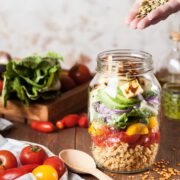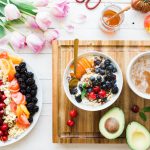Foods That Fuel: Dietitian Sally Poon Shares Her Dance Nutrition Tips
Driven by the athleticism, artistry and aesthetics of dance, many dancers find themselves in a whirlwind of personal health and fitness goals. It can be mind-boggling for young dancers to figure out how to fuel their bodies. Though we each have a unique physical composition, there are a few dietary tips that every dancer should take note off. Here to share her advice on nutrition for dancers is one of Hong Kong’s leading dietitians, Sally Poon.
How can dancers keep their energy up throughout the day?
S.P.: For competition or stage performance preparation, it is important to ensure that adequate dietary intake is being achieved. Eat frequent meals and snacks throughout the day. Do not skip meals. Always consume a snack to replenish your energy within 30 minutes after training.
In between training sessions and performances, dancers should give special attention to fluid and carbohydrate intake in order to maintain optimal cognition and motor skill performance. Dehydration can cause tiredness and hinder performance by reducing strength and aerobic capacity. Impaired skill level can also occur, along with mental fatigue that can impact concentration and decision making. The amount an individual sweats varies from person to person, therefore fluid needs are highly individualised. Generally, the more a person sweats, the more they will need to drink. When the body is well hydrated, the colour of urine should be pale yellow throughout the day. Water is suitable for low intensity and short duration exercise. Sports drinks can be useful in high intensity or endurance training, as they contain both carbohydrates for fuel and sodium to help the body retain fluid more effectively and stimulate thirst.
What types of dietary risks are dancers prone to?
S.P.: The risk of poor micronutrient status due to restricted energy intake may be higher for dancers. Micronutrients that warrant attention include iron, calcium, and vitamin D. Our body needs iron to make haemoglobin, a protein in red blood cells that carries oxygen to all parts of the body. Low levels of iron in the body can cause iron deficiency anaemia. Symptoms include weakness, tiredness, difficulty concentrating, as well as impaired immune function and recovery.
It is important that dancers seek dietary advice from qualified dietitians, due to the great amount of pressure to maintain a low body weight and low body fat levels, especially among ballet dancers. And this can lead to unbalanced eating habits and health issues if it is not properly supervised. Evidence suggests that disordered eating, menstrual disturbances, and low bone mineral density are the key health issues for dancers at all skill levels. Low bone mineral density is associated with clinical outcomes of osteopenia and osteoporosis. A study found that dancers had three times the risk of suffering from eating disorders.

Photo by Jess Bailey on Unsplash
What are some ways that dancers can develop or maintain strong and healthy bones?
S.P.: Adequate calcium and vitamin D are crucial to maintain proper bone health. Milk, yogurt, and cheese are the main food sources of calcium. Dark green vegetables, tofu, canned sardines, and calcium-fortified beverages are good sources of calcium too. Vitamin D helps the body absorb calcium and is important to keep our immunity strong. The body makes vitamin D when skin is directly exposed to the sun. Only a few foods naturally have vitamin D, which include fatty fish (such as salmon, tuna, and mackerel), egg yolks, mushrooms that have been exposed to ultraviolet light, as well as fortified foods and beverages (such as breakfast cereals, yogurt, milk, soy milk, and orange juice). Dietary supplements may be necessary to help achieve specific nutritional goals when dietary intake is inadequate.

Photo by Tetiana Bykovets on Unsplash
5 Fuelling Foods Packed with Nutrition
- Nuts are a good source of protein, healthy monounsaturated fats and dietary fibre. They also contain vitamin E, calcium, potassium, magnesium, and iron. Protein can enhance muscle repair and building; vitamin E is important for the immune system; and salted nuts with fluids can enhance rehydration.
- Fruits are rich in carbohydrates, dietary fibre, vitamin C, and potassium. Carbohydrates are an important energy source during exercise. Inadequate carbohydrate intake combined with regular training can lead to tiredness, loss of muscle mass and poor recovery. Carbohydrates are also needed to provide fuel to the brain, therefore low carbohydrate diets can result in poor concentration, mood swings and depression. Vitamin C is crucial to keep the immune system strong.
- Milk contains protein, calcium, and phosphorus that can promote muscle function and bone health. It also includes a source of fluid and sodium to enhance rehydration.
- Eggs are rich in protein for growth, repair and maintenance of muscles. Eggs also contain high concentrations of antioxidants lutein and zeaxanthin; as well as choline which is involved in the regulation of memory, mood, and muscle control.
- Quinoa is classified as a whole grain and is a good source of protein, dietary fiber, and iron. Quinoa is a complete protein, meaning that it contains all nine essential amino acids that the body cannot make on its own.

Photo by Dane Deaner on Unsplash
A List of Energy Boosting Snack Suggestions for Dancers
- Cereal bars
- Nut bars
- Energy balls
- Fruit smoothies
- Trail mix with dried fruits
- Yogurt with almonds and fruits
- Egg/ tuna/ cheese sandwich
- Peanut butter banana sandwich
- Apple walnut muffins
- Banana nut bread
- Small tin of tuna on crackers with a banana
- Vegetables sticks and pita bread with hummus

Photo by Toa Heftiba on Unsplash
What are some key foods and food groups that dancers should incorporate into their daily diet?
S.P.: Grains should be taken as the major dietary source, such as rice, noodles, pasta, bread, cereals, oatmeal, granola bars, and crackers. Eat more fruits and vegetables – make your meals as colourful as possible! Have a moderate amount of lean meat, skinless poultry, fish and seafood, beans, tofu, eggs, and low-fat dairy. Include some healthy fats with meals and snacks, such as nuts and seeds, avocado, nut butter, olive oil, salmon and tuna.
Ready to fuel up and take the stage, let’s open our pantry and keep our dance bags packed with delicious and energizing snacks! A special thank you to leading dietitian Sally Poon for sharing her expertise on nutrition for dancers!

Sally, Shi-Po Poon 潘仕寶
Registered Dietitian (UK)
Accredited Practising Dietitian (Australia)
BSc Nutrition (King’s College, London)
Master of Nutrition & Dietetics (The University of Sydney, Australia)
Sports Nutrition (HKUSPACE)
For more nutrition tips follow Sally on:
Instagram: @sallypoondietitian
This article was posted on the Hong Kong Dance Magazine website on 25 May 2020:
https://hkdancemagazine.com/stories/2020/5/23/foods-that-fuel-dietitian-sally-poon-shares-her-dance-nutrition-tips?fbclid=IwAR2M8d2w876y_TB5WUhRpgHM7k4C1L4-gsB5XSW_ylobJsI5ddkkeD5vtp4










Leave a Reply
Want to join the discussion?Feel free to contribute!